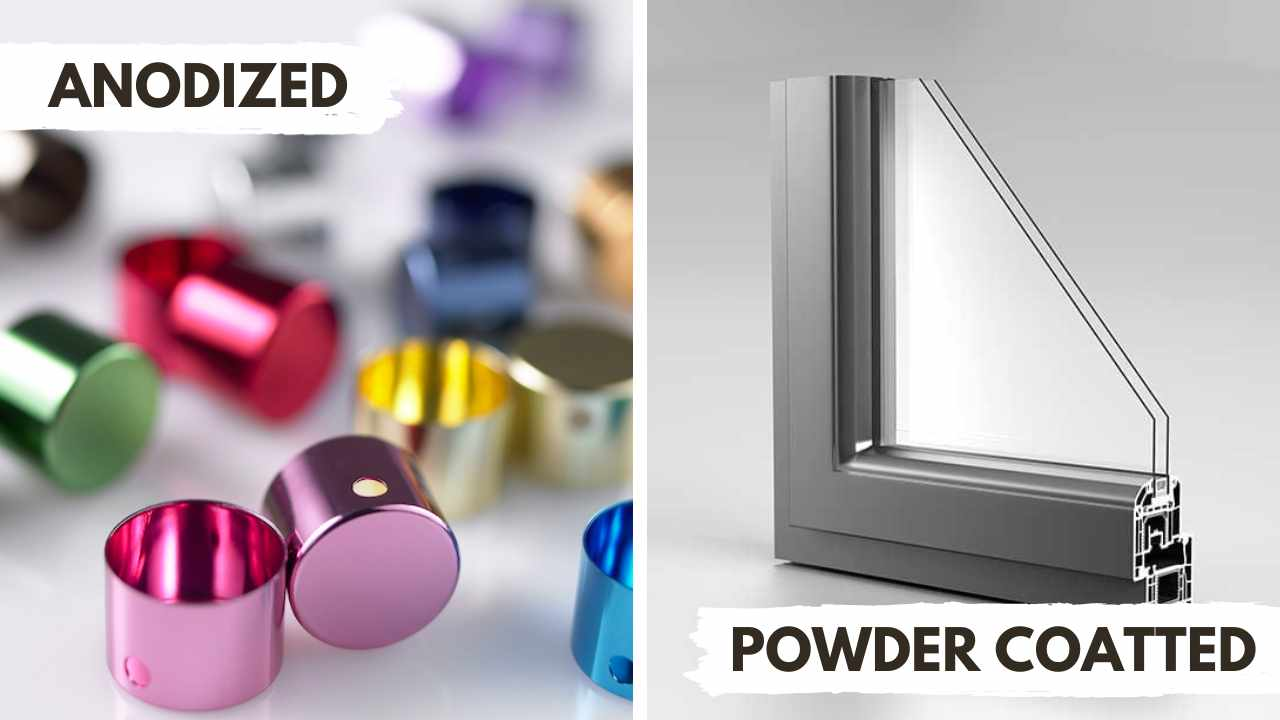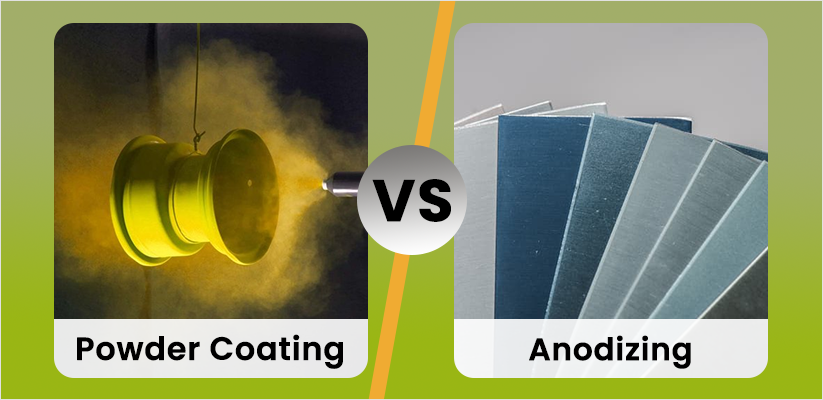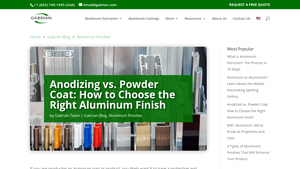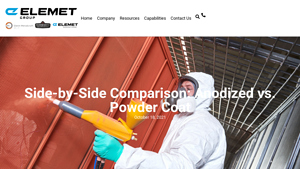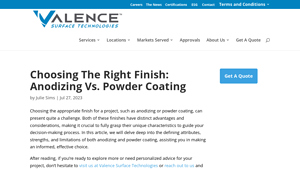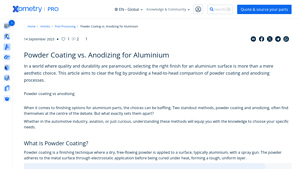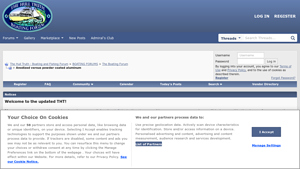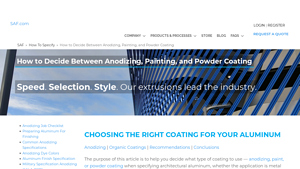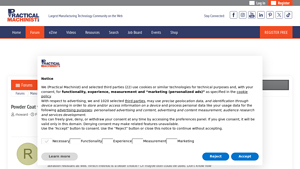Anodized Aluminum Vs Powder Coating Guide: Type, Cost, Top List…
Introduction: Navigating the Global Market for anodized aluminum vs powder coating
In a competitive global market, understanding the nuances of aluminum finishes—particularly anodized aluminum and powder coating—can be a pivotal factor for international B2B buyers seeking to enhance product durability and aesthetic appeal. Each finishing option presents unique advantages tailored to specific applications and environmental demands, making the decision process challenging. This guide addresses the vital considerations that influence your sourcing strategies, from the technical specifications of anodizing and powder coating to their respective applications across various industries.
Throughout this comprehensive analysis, we will explore the characteristics, benefits, and limitations of both finishing methods, helping you to navigate supplier vetting and evaluate cost implications. By delving into the environmental impact, desired longevity, and maintenance requirements associated with these finishes, this guide empowers you to make informed purchasing decisions that align with your business goals. Whether you are located in Africa, South America, the Middle East, or Europe—including emerging markets like Vietnam and established industries in Germany—our insights are designed to support your strategic planning. As you consider your options, you will gain the knowledge needed to select the finishing process that not only meets your product specifications but also elevates your brand in the international marketplace.
Understanding anodized aluminum vs powder coating Types and Variations
| Type Name | Key Distinguishing Features | Primary B2B Applications | Brief Pros & Cons for Buyers |
|---|---|---|---|
| Standard Anodizing | Enhances natural oxide layer; corrosion-resistant | Aerospace, automotive, architectural | Pros: Excellent durability, UV resistance; Cons: Limited color options. |
| Hard Anodizing | Thicker oxide layer; excellent wear resistance | Military, industrial machinery | Pros: Superior hardness, great for high-stress applications; Cons: Higher cost, longer processing time. |
| Color Anodizing | Dyes can be added during anodizing process | Consumer goods, decorative items | Pros: Aesthetic appeal, customization options; Cons: Color fading in intense UV exposure. |
| Polyester Powder Coating | Durable, UV-resistant; available in many colors | Appliances, automotive parts | Pros: Wide color range, cost-effective; Cons: Less hardness compared to anodizing. |
| Epoxy Powder Coating | Chemical resistance; softer finish | Industrial applications, indoor use | Pros: Excellent adhesion, cost-efficient; Cons: Not suited for outdoor environments. |
What Are the Characteristics of Standard Anodizing?
Standard anodizing creates a layer of aluminum oxide through an electrochemical process. This enhances the material’s natural corrosion resistance and durability, making it suitable for industries such as aerospace and automotive. When procuring this finish, buyers should consider factors like the desired longevity and need for aesthetic enhancement, as color options are limited.
What Sets Hard Anodizing Apart?
Hard anodizing features a significantly thicker aluminum oxide layer, offering enhanced wear resistance ideal for demanding applications like military and heavy machinery. B2B buyers should note the application’s operational environment, as this process may come at a higher price and greater time commitment, but it is worth the investment for parts facing frequent abrasion.
How Does Color Anodizing Provide Customization?
Color anodizing involves adding dyes to the anodizing bath, allowing for a range of color finishes that appeal to consumer goods markets. While providing aesthetic benefits, this process does entail certain compromises, particularly regarding UV resistance, and can lead to fading in high-exposure environments. Buyers must weigh their aesthetic goals against longevity needs.
Why Consider Polyester Powder Coating?
Polyester powder coating stands out for its durability and UV resistance, available in a wide color palette, which makes it a popular choice for appliances and automotive parts. This coating provides an economical solution, yet potential buyers should be mindful of its softer finish compared to anodizing and may need to evaluate it against application requirements for wear resistance.
What Are the Benefits of Epoxy Powder Coating?
Epoxy powder coating is distinguished by its chemical resistance and smooth finish, making it suitable for indoor applications in industrial settings. While it’s a cost-effective option, businesses must be cautious about using it outdoors, as it can deteriorate under UV exposure. This consideration is crucial for buyers focused on long-term durability in varied environments.
Key Industrial Applications of anodized aluminum vs powder coating
| Industry/Sector | Specific Application of anodized aluminum vs powder coating | Value/Benefit for the Business | Key Sourcing Considerations for this Application |
|---|---|---|---|
| Automotive | Anodized aluminum for engine components and chassis parts | Enhanced heat resistance and weight savings | Ensure compatibility of anodizing process with local standards, consider environmental regulations. |
| Construction & Architecture | Powder coating for aluminum window frames and facade cladding | Extensive color options and aesthetic appeal | Verify the durability of powder coat against local climate conditions and maintenance needs. |
| Electronics | Anodized aluminum housings for electronic enclosures | Excellent corrosion resistance and thermal management | Assess the specific thickness and surface finish according to electronic safety standards. |
| Consumer Goods | Powder coating for furniture and appliances | Variety in finishing textures and colors | Identify suppliers with sustainable practices and adhere to quality control measures. |
| Marine | Anodized aluminum fittings and hardware | Superior corrosion resistance in saline environments | Focus on long-term performance in coastal areas and certifications related to marine applications. |
How is Anodized Aluminum Beneficial in the Automotive Sector?
In the automotive sector, anodized aluminum is commonly used for engine components, brackets, and chassis parts due to its exceptional durability and heat-resistant properties. This process creates a robust oxide layer that enhances the metal’s hardness, providing better wear resistance compared to untreated aluminum. For international B2B buyers, it’s essential to evaluate how anodized finishes can withstand high-stress environments specific to various geographical conditions, such as extreme temperatures and humidity levels, ensuring compatibility with local automotive standards.
What Advantages Does Powder Coating Offer in Construction & Architecture?
Powder coating serves a critical role in the construction industry, particularly for aluminum window frames and building facade cladding. This finishing technique provides an aesthetic appeal with a vast array of color options while delivering durability against environmental exposure. Buyers should consider the local climate impacts on powder coating longevity, ensuring the selected finish meets regional building codes. It is also advisable to work with suppliers who can provide a detailed maintenance regimen tailored to specific environments, enhancing the product lifecycle.
Why Choose Anodized Aluminum for Electronics?
Anodized aluminum is an excellent choice for electronic enclosures due to its superior corrosion resistance and thermal conductivity. The anodizing process not only offers a protective layer that guards against wear and tear but also ensures better performance in heat dissipation, which is crucial for electronic devices. B2B buyers in this sector must assess the thickness and quality of the anodized finish to comply with electronic safety standards, particularly when sourcing from international suppliers to ensure consistent quality across production batches.
How Can Powder Coating Fulfill Consumer Goods Needs?
In the consumer goods sector, powder coating is widely used for furniture, appliances, and decorative items due to its ability to provide unique textures and vibrant colors. This process allows for customization that can address diverse market needs while ensuring a durable finish that resists chipping and fading. When sourcing powder coatings, businesses should inquire about the supplier’s environmental practices, as well as the compliance of their coatings with international safety standards, particularly around VOC emissions, to meet globally-conscious market demands.
What Makes Anodized Aluminum Essential for Marine Applications?
For marine applications, anodized aluminum fittings and hardware are preferred because the anodizing process significantly improves corrosion resistance against saline environments. This added protection extends the longevity of components exposed to harsh maritime conditions. International buyers focusing on marine hardware need to verify that anodizing processes meet specific marine certifications and durability expectations, particularly in coastal regions where saltwater exposure is prevalent. Ensuring a reliable supply of anodized components is critical for maintaining performance over time, making it essential to partner with experienced anodizing specialists.
3 Common User Pain Points for ‘anodized aluminum vs powder coating’ & Their Solutions
Scenario 1: The Challenge of Choosing the Right Finish for Environmental Resistance
The Problem: In regions with extreme weather or variable environmental conditions, B2B buyers often grapple with the decision between anodized aluminum and powder coating. For instance, a buyer in the Middle East may need to ensure their aluminum products withstand high temperatures, sand abrasion, and UV exposure. Each finishing option presents its unique strengths and weaknesses, complicating the decision-making process. Anodized coatings excel in wear resistance but can falter in high pH environments. Conversely, while powder coatings offer excellent UV and corrosion resistance, they may not endure extreme heat without degrading. This dilemma can lead to costly project delays and potential product failures if the wrong finish is chosen.
The Solution: B2B buyers should conduct a thorough analysis of the intended application environment before selecting the coating option. It’s vital to assess environmental factors such as temperature, humidity, and chemical exposure levels. Collaborating with a trusted finishing expert can yield insights into how different coatings perform under specific scenarios. For example, if UV resistance is paramount, a high-quality powder coating formulated for extreme conditions should be specified. On the other hand, for applications where wear is critical, investing in anodizing, particularly with a thicker layer of aluminum oxide, can extend product lifespan significantly. Engaging in testing with samples in real or simulated environments can also help validate the durability of the chosen finish.
Scenario 2: The Cost-Effectiveness Dilemma in Large Production Runs
The Problem: In the context of managing budgets and maximizing return on investment, B2B buyers often encounter challenges related to the cost-effectiveness of choosing between anodized aluminum and powder coating. Buyers from industries such as automotive or construction may require large quantities of finished products and are sensitive to production costs. Anodizing typically incurs a higher initial setup cost, especially for smaller runs, leading companies to question its economic viability. Meanwhile, powder coating, while generally more affordable for larger scales, incurs long-term costs if it fails prematurely due to improper application or environmental wear.
The Solution: To optimize costs, manufacturers can leverage economies of scale by specifying powder coating for larger production runs while utilizing anodizing for specialized or premium products where performance justifies the cost. Establishing clear communication with suppliers about volume estimates allows them to provide tailored quotes and alternative options. Implementing robust quality control measures during the finishing process can mitigate long-term costs associated with failures. Buyers should also consider lifecycle cost analysis beyond initial pricing, weighing potential savings in maintenance and replacement for products exposed to harsh conditions. By integrating supply chain partners that offer both anodization and powder coating services, businesses can maintain flexibility and react swiftly to market demands.
Scenario 3: Navigating Supply Chain Limitations for Specialty Finishes
The Problem: Many B2B buyers experience frustration when the availability of specific finishes is hindered by supply chain issues, particularly in less accessible regions. For example, a buyer in Africa may face unexpected delays due to shipping constraints for anodized aluminum products or limited local suppliers for powder coating services. Such interruptions not only threaten production schedules but can also compromise project delivery timelines, risking client satisfaction.
The Solution: B2B buyers should cultivate relationships with multiple suppliers, ensuring backups exist in case of disruptions. Establishing contracts with local or regional finishing companies can alleviate transportation delays and provide a buffer against international shipping challenges. Additionally, it’s crucial to communicate lead times and inventory levels early in project planning. Incorporating advanced ordering practices can mitigate risks associated with long supply chains—ordering increased inventory of anodized or powder-coated components during peak production seasons can ensure availability when demand rises. Finally, employing digital tracking solutions can enhance visibility over the supply chain, allowing buyers to proactively address potential bottlenecks and maintain smooth operations.
Strategic Material Selection Guide for anodized aluminum vs powder coating
In-Depth Analysis of Anodized Aluminum vs. Powder Coating
When deciding between anodized aluminum and powder coating, B2B buyers must consider each material’s key properties, advantages, disadvantages, and applications. Here, we analyze the implications of these coatings across several critical dimensions.
What are the Key Properties of Anodized Aluminum?
Anodized aluminum features an electrochemically enhanced oxide layer that significantly boosts the material’s ability to withstand corrosion and abrasion. One of its key properties is its temperature resistance, suitable for environments with continuous exposure to temperatures up to 80 ºC (176 ºF). The anodized finish also maintains excellent performance in humid or saline environments, making it ideal for coastal applications.
Pros and Cons of Anodized Aluminum
Anodizing provides several advantages, including exceptional durability and longevity due to the formation of a hard, integral layer on the aluminum surface. The process is also customizable—varying voltage and electrolyte solutions can optimize properties for specific applications. However, costs can be higher compared to other coatings, particularly for small batch sizes. Additionally, anodized aluminum’s aesthetic appeal can be limited as it typically presents a matte finish unless dyed.
What are the Key Properties of Powder Coating?
Powder coating is a finishing process in which a dry powder is electrostatically applied to a metal surface and cured under heat. The resulting finish is smooth, tough, and highly resistant to corrosion, UV light, and chemicals. Unlike anodized coatings, powder coatings can be applied on a broader range of substrates, including plastics and wood, expanding versatility.
Pros and Cons of Powder Coating
The primary advantage of powder coating is its cost-effectiveness, especially for large-scale applications. The process generates minimal waste, making it an environmentally friendly choice compared to traditional liquid paints. While powder coatings are durable and resistant to corrosion, they are generally softer than anodized finishes, leading to wear under abrasive conditions. Additionally, powder-coated surfaces can chip and scratch more easily; thus, their suitability varies based on environmental conditions and loading requirements.
Impact on Application Specific Media Compatibility
For businesses operating in environments with exposure to harsh chemicals or corrosive elements, anodized aluminum often outperforms powder coating due to its inherent properties. Applications in electronics, architecture, and automotive industries may find anodized aluminum not only more durable but also enhancing the product’s aesthetic without compromising on safety. Conversely, powder coating might be preferable for consumer goods that prioritize color variety and overall cost.
Specific Considerations for International B2B Buyers
B2B buyers in regions like Africa, South America, the Middle East, and Europe must consider compliance with international standards such as ASTM, DIN, and JIS during material selection. In markets like Germany, a preference for environmentally friendly production processes could steer buyers toward powder coating due to its reduced toxic byproducts. In contrast, buyers in more humid regions like Vietnam may favor anodized aluminum for its superior corrosion resistance.
Summary Table of Material Comparison
| Material | Typical Use Case for anodized aluminum vs powder coating | Key Advantage | Key Disadvantage/Limitation | Relative Cost (Low/Med/High) |
|---|---|---|---|---|
| Anodized Aluminum | Automotive parts, architectural extrusions | Superior corrosion resistance | Higher initial cost | High |
| Powder Coating | Consumer goods, furniture, machinery | Cost-effective for large batches | Softer finish, prone to chipping | Medium |
| Anodized Aluminum | Electronics housings, marine applications | Hard and durable finish | Limited color customization | High |
| Powder Coating | Industrial equipment, appliances, outdoor structures | Environmentally friendly process | Less durable against abrasion | Medium |
Understanding these considerations will better equip B2B buyers to make informed decisions when selecting between anodized aluminum and powder coating, aligning their procurement strategy with application-specific needs and regional compliance standards.
In-depth Look: Manufacturing Processes and Quality Assurance for anodized aluminum vs powder coating
What Are the Key Stages in the Manufacturing Process for Anodized Aluminum and Powder Coating?
Material Preparation for Both Finishes
The manufacturing process for both anodized aluminum and powder-coated aluminum begins with meticulous material preparation. For anodizing, the aluminum substrate must be cleaned to remove any impurities or oxidation that might impede the anodizing process. This is typically achieved through chemical cleaning solutions or abrasive methods, followed by rinsing. In contrast, for powder coating, the metal surface must undergo rigorous degreasing and surface profiling (e.g., sandblasting) to ensure optimal adhesion of the powder.
Both processes emphasize the importance of achieving a contaminant-free surface, as any residual dirt or oils can lead to compromised coating integrity.
How is the Aluminum Formed and Assembled Before Finishing?
Once the material is prepared, the next step involves forming and assembling the aluminum components. This stage often includes processes like extrusion, bending, or machining to create specific profiles suited to various applications. Anodized aluminum is often allowed to maintain its original dimensions, as the anodizing process enhances the surface without altering size significantly.
For powder coating, components are typically pre-assembled before application, as it is more efficient to coat assembly units rather than individual parts. The assembly process must ensure that all parts fit together perfectly, as any gap could lead to inferior coating quality during the powder application.
What Are the Finishing Techniques Used in Anodizing and Powder Coating?
Understanding the Anodizing Process
Anodizing is an electrochemical process where aluminum parts are submerged into an electrolyte bath. An electric current is then passed through the solution, creating an aluminum oxide layer that not only increases corrosion resistance but also provides an aesthetic finish that can be dyed in various colors. The thickness of the anodized layer can be controlled by adjusting the voltage and duration of the electrical current applied.
Exploring the Powder Coating Method
Powder coating entails applying a dry powder that is electrically charged and sprayed onto the grounded aluminum surface. The coated parts are then cured in an oven, where the heat causes the powder to flow and create a uniform, durable finish. This technique allows for a wide range of colors and textures, making it popular among manufacturers looking for aesthetic appeal in addition to functional benefits.
What Quality Assurance Practices Are Essential for Anodized and Powder-Coated Products?
International and Industry-Specific Standards
Quality assurance is paramount in manufacturing processes, particularly for B2B buyers who must ensure the reliability and durability of the products they source. Adhering to international standards such as ISO 9001 guarantees that manufacturers implement quality management systems that enhance efficiency and customer satisfaction. Industry-specific certifications like CE (Conformité Européenne) for products sold in Europe or API (American Petroleum Institute) for equipment in oil and natural gas are equally critical, establishing compliance with industry norms and enhancing buyer confidence.
What Are the Key Quality Control Checkpoints?
The manufacturing process for both anodized and powder-coated products features several quality control checkpoints:
-
Incoming Quality Control (IQC): This stage ensures that raw materials meet specified standards before production begins. This includes inspections of metal quality, dimensions, and coating materials.
-
In-Process Quality Control (IPQC): During manufacturing, continuous assessments are conducted to verify that production tolerances are maintained. This can include monitoring the voltage and timing during anodizing or the application process in powder coating to ensure uniformity.
-
Final Quality Control (FQC): Completed products undergo rigorous testing, which can include visual inspections, adhesion tests, and mechanical property evaluations. For anodized finishes, tests may focus on corrosion resistance and thickness measurement, while powder-coated items are typically subjected to impact and scratch resistance evaluations.
How Can B2B Buyers Verify Supplier Quality Control?
Conducting Audits and Inspection
B2B buyers, particularly those in regions such as Africa, South America, and the Middle East, should prioritize thorough audits of suppliers. Establishing a clear understanding of a supplier’s quality management practices can involve site visits and inspections, where you can observe the manufacturing process, quality checkpoints, and product testing firsthand.
Additionally, requesting documented quality control reports and certifications related to specific standards can provide significant assurance regarding a supplier’s commitment to quality. Third-party inspections by accredited organizations can also serve as an independent verification method to ensure that suppliers adhere to claimed quality assurance measures.
What Nuances Should International Buyers Consider in Quality Control?
Understanding Regional Compliance Standards
B2B buyers from different regions must also navigate varying compliance requirements. In Europe, for example, CE marking is a regulatory requirement that signifies conformity to health, safety, and environmental protection standards. Conversely, other regions may prioritize different certifications or industry-specific standards.
When engaging with suppliers, it’s essential to communicate your specific compliance needs such that they align their processes accordingly. Buyers should also educate themselves on how local regulations might impact production processes and the resultant quality of anodized or powder-coated products.
Conclusion
Understanding the manufacturing processes and the quality assurance landscape of anodized aluminum versus powder coating is crucial for B2B buyers. Paying close attention to the details involved in production, quality control checkpoints, and regional compliance will empower buyers to make informed decisions. By rigorously vetting suppliers and establishing clear quality expectations, businesses can secure high-quality aluminum products tailored to their operational needs.
Practical Sourcing Guide: A Step-by-Step Checklist for ‘anodized aluminum vs powder coating’
By choosing the right finish for aluminum products, buyers can significantly enhance durability, aesthetic appeal, and functionality. This guide offers practical steps for B2B buyers evaluating anodized aluminum versus powder coating, helping them make informed sourcing decisions.
Step 1: Define Your Technical Specifications
Begin by clearly outlining the technical requirements of your project. Consider factors such as environmental exposure, desired longevity, and aesthetic preferences, as these will influence the suitability of anodized aluminum or powder coating. Each finish has distinct properties; understanding your specifications will guide you toward the best choice.
Step 2: Assess Performance Requirements
Evaluate how each coating performs in your specific application.
– Durability: Anodizing offers superior wear resistance, while powder coating excels in chemical resistance.
– Environmental Resistance: Consider factors such as UV exposure, humidity, and temperature ranges that could affect the longevity of the finishes.
Step 3: Verify Supplier Certifications
Ensure your potential suppliers hold necessary certifications that validate their process quality and environmental standards.
– Certifications: Look for ISO certifications or industry-specific qualifications like PCI for powder coating.
– Experience: Verify the supplier’s experience with both anodizing and powder coating to ensure they can meet your needs.
Step 4: Request Samples and Performance Data
Don’t hesitate to ask suppliers for sample products and performance data relevant to your project.
– Sample Analysis: Inspect samples of anodized and powder-coated finishes to assess quality, feel, and durability.
– Data Sheets: Performance data that illustrates resistance to wear, UV exposure, and corrosion can help you make objective comparisons.
Step 5: Consider Cost Factors
Analyze the total cost of both finishes, taking into account initial investment and long-term maintenance expenses.
– Initial Costs: Powder coating is often more cost-effective for larger batches due to its efficiency.
– Longevity: Anodized finishes may require less maintenance, potentially lowering overall costs over time.
Step 6: Evaluate Customization Options
Explore the customization potential for both finishes.
– Color and Aesthetics: Anodizing allows for a variety of hues through dyeing, while powder coating offers a wide selection of colors and textures.
– Thickness Options: Understand how different thickness options for anodized coatings can enhance durability based on specific application needs.
Step 7: Review Environmental Considerations
Understand the environmental impact of each finishing process as part of your sourcing decision.
– Byproducts and Safety: Anodizing can generate hazardous waste, which may require mitigation strategies. Conversely, powder coating is more environmentally friendly, producing minimal waste.
– Sustainability Practices: Consider suppliers who implement sustainable practices and processes, as this may align with your corporate social responsibility goals.
By following this checklist, B2B buyers can strategically select the most appropriate finishing method for aluminum products, ensuring the chosen finish aligns with both project requirements and organizational values.
Comprehensive Cost and Pricing Analysis for anodized aluminum vs powder coating Sourcing
What Are the Key Cost Components in Sourcing Anodized Aluminum and Powder Coating?
When considering the sourcing of anodized aluminum and powder coating, understanding the cost structure is vital. The principal cost components include material costs, labor expenses, manufacturing overhead, tooling, quality control (QC), logistics, and suppliers’ margins.
-
Material Costs: Raw materials form the backbone of cost structures for both anodized aluminum and powder coating. For anodization, aluminum prices fluctuate based on quality and global supply. Powder coating involves pigments and resin, which can also vary significantly. It’s essential to consider the type and quality of materials required for your intended application.
-
Labor Expenses: Labor costs have a direct impact on pricing. Anodization processes tend to require skilled labor for electrochemical processes, which may increase labor costs. In contrast, powder coating is often more automated, potentially reducing labor costs.
-
Manufacturing Overhead: This includes the cost of utilities, equipment maintenance, and factory operations. Anodizing typically involves more specialized equipment, which may result in higher overhead costs compared to the relatively simpler setup required for powder coating.
-
Tooling Costs: Custom tooling can represent a significant investment for either process. If the production requires unique aluminum extrusions for anodizing or specialized machinery for powder coating, these costs can escalate quickly.
-
Quality Control: Both processes necessitate rigorous quality control to ensure product reliability. Anodizing may require extensive testing to ensure appropriate thickness and quality of the oxide layer, potentially adding to costs. In contrast, powder coating might require less testing, but surface preparation for effective adhesion can add complexity.
-
Logistics: The efficiency of logistics operations also influences pricing. Anodized aluminum can be more fragile and may require careful handling and transportation, impacting shipping costs. Powder-coated items, generally more robust, might be shipped more economically.
-
Supplier Margins: Margins can vary based on supplier relationships, market demand, and order volume. Negotiating margins with suppliers can lead to significant savings.
Which Price Influencers Should Buyers Consider in International Markets?
Various factors influence pricing in both local and international contexts, particularly for B2B buyers in regions like Africa, South America, the Middle East, and Europe.
-
Volume and Minimum Order Quantity (MOQ): Bulk purchases often yield better pricing. Negotiating lower MOQs or higher volume contracts can facilitate economies of scale.
-
Specifications and Customization: Custom specifications lead to increased production complexity and costs. Buyers should weigh the benefits against potential added expenses.
-
Material Quality and Certifications: Higher quality materials or specialized certifications (ISO, CE, etc.) usually incur higher costs but can justify the expense with improved performance and regulatory compliance.
-
Supplier Factors: Reliability and reputation of the supplier also impact pricing. Established suppliers may command higher prices due to their perceived quality and service levels.
-
Incoterms: Costs can dramatically shift based on shipping terms and responsibilities defined by Incoterms. For international transactions, understanding who bears the risk and cost of transport, handling, and insurance is crucial.
How Can Buyers Enhance Cost-Efficiency in Sourcing Processes?
Achieving cost-efficiency in sourcing anodized aluminum and powder coating involves strategic negotiation and consideration of the Total Cost of Ownership (TCO).
-
Negotiation Tactics: Building strong relationships with suppliers can enable better negotiation opportunities. Seeking long-term partnership agreements can lead to better pricing structures and reliability.
-
Understanding Total Cost of Ownership (TCO): TCO extends beyond the initial sourcing price. Factors like maintenance, durability, environmental impact, and longevity should factor into the decision-making process.
-
Navigating Pricing Nuances: International buyers must be aware of region-specific pricing variables, including tariffs, duties, and currency fluctuations. Keeping abreast of local market trends can help anticipate cost changes and prevent unexpected financial impact.
In conclusion, understanding the comprehensive cost structure and pricing influencers for anodized aluminum versus powder coating is critical for B2B buyers. Leveraging these insights can enhance negotiation power and optimize sourcing strategies in a competitive global market.
Disclaimer: Prices mentioned and discussed in this analysis are indicative and subject to change based on market fluctuations and supplier negotiations.
Alternatives Analysis: Comparing anodized aluminum vs powder coating With Other Solutions
Introduction: Understanding Alternatives in Aluminum Finishing
When selecting a protective finish for aluminum components, businesses often consider anodized aluminum and powder coating as their primary options. However, other viable alternatives can provide unique benefits and considerations. This section delves into key comparisons, highlighting how anodized aluminum and powder coating stack up against alternatives like e-coating and liquid painting, enabling informed decision-making for international B2B buyers.
Comparison Table
| Comparison Aspect | Anodized Aluminum Vs Powder Coating | E-Coating | Liquid Painting |
|---|---|---|---|
| Performance | Excellent wear and UV resistance; long-lasting finish. | Highly uniform coating with strong corrosion resistance. | Good appearance, but less durable over time. |
| Cost | More expensive but better for high-end applications. | Generally cost-effective for high-volume production. | Lower initial costs but can lead to higher long-term maintenance. |
| Ease of Implementation | Requires specialized processes and facilities. | Requires specific equipment; typically less labor-intensive. | Versatile application methods, but surface prep is critical. |
| Maintenance | Low maintenance; resistant to peeling/flaking. | Low maintenance; durable finish. | Higher maintenance due to potential chipping or fading. |
| Best Use Case | High-end architectural or aerospace components. | Automotive or industrial applications needing uniformity. | Decorative items or lower-stress environments. |
Detailed Breakdown of Alternatives
E-Coating: What Are its Benefits and Drawbacks?
E-coating, or electrophoretic coating, is an electrochemical process where paint particles are deposited onto a conductive surface. This method excels in providing uniformity and strong corrosion resistance, making it ideal for automotive and industrial applications. The upfront costs are often lower compared to anodizing or powder coating, and the process is suitable for high-volume production. However, it may not reach the same level of hardness or wear resistance as anodized finishes.
Liquid Painting: When is it Most Appropriate?
Liquid painting involves applying a liquid coating, which can provide a vast array of color options and finish styles. It excels in aesthetic versatility and can be easily applied in various environments. However, while liquid paints can deliver good initial appearances, they may suffer from durability issues compared to anodized or e-coating options, particularly under harsh environmental conditions. This leads to higher maintenance costs over time, as the painted surface can chip or fade.
Conclusion: How to Choose the Right Solution for Your Needs
For B2B buyers, the decision between anodized aluminum, powder coating, and alternative methods should be grounded in the specific requirements of the application, cost considerations, and longevity expectations. Assessing performance needs, maintenance capabilities, and aesthetic goals will guide the choice. By understanding the nuances of each finishing technique, businesses can make informed decisions that align with their operational goals and budget constraints, ensuring product durability and customer satisfaction.
Essential Technical Properties and Trade Terminology for anodized aluminum vs powder coating
What are the Key Technical Properties of Anodized Aluminum and Powder Coating?
1. Material Grade
Material grade is crucial when selecting aluminum for either anodizing or powder coating. Grades such as 6061 and 6063 are commonly used in manufacturing due to their excellent mechanical properties and corrosion resistance. For B2B buyers, understanding material grades can impact product performance and compliance with industry standards, which may be vital for sectors like automotive or aerospace where safety and durability are paramount.
2. Coating Thickness
This refers to the measurement of the anodized layer or powder coat applied to the aluminum. Anodized coatings typically range from 5 to 25 microns, while powder coatings can vary from 30 to 125 microns. Thicker coatings offer enhanced durability and corrosion resistance, making them essential in harsh environments. Buyers should specify coating thickness in their orders to ensure performance aligns with application demands, improving both product longevity and customer satisfaction.
3. Adhesion Strength
Adhesion strength measures how well the coating adheres to the substrate. For anodized aluminum, this is inherently strong given that the layer is part of the metal itself. In contrast, powder coating relies on mechanical bonding, which can be influenced by pre-treatment processes. Ensuring proper adhesion is vital to prevent premature coating failure, which could lead to costly returns or replacements.
4. Wear Resistance
This property is particularly important in high-traffic or industrial applications. Anodized aluminum typically exhibits superior wear resistance due to the hard nature of the aluminum oxide layer, while powder-coated surfaces are softer but can provide decent resistance depending on the formulation. Buyers must consider the operational environment and mechanical demands of the product to choose the appropriate finish that minimizes wear and operational disruptions.
5. Corrosion Resistance
Corrosion resistance is pivotal, especially for applications in coastal or industrial environments. Anodized finishes form a protective layer that withstands corrosive elements effectively. Powder coatings also resist corrosion but vary according to chemistry and thickness. Understanding the environmental conditions and required durability can guide the selection process, ensuring that B2B products remain reliable over time.
6. UV Resistance
Exposure to UV rays can degrade coatings over time. Anodized aluminum offers inherent UV resistance due to the nature of its oxide layer, while powder-coated finishes can be formulated for enhanced UV protection using specific resins. This is a critical consideration for outdoor applications, where aesthetic and functional integrity is necessary. Buyers should assess their surroundings to select a suitable finish that withstands UV exposure effectively.
What Terminology Should B2B Buyers Understand in the Context of Finishes?
1. OEM (Original Equipment Manufacturer)
This term refers to companies that produce parts or equipment that are then sold by another company under its brand name. In the context of anodized aluminum and powder coating, OEMs often specify finishing requirements to ensure product compatibility with their manufacturing processes. B2B buyers should be aware of OEM standards to avoid mismatches in product quality.
2. MOQ (Minimum Order Quantity)
MOQ indicates the smallest order a supplier is willing to accept. Understanding MOQ is essential for managing budgets and inventory—especially when custom finishes are involved. Buyers need to ensure that their orders meet the supplier’s MOQ to facilitate cost-effective procurement and supply chain management.
3. RFQ (Request for Quotation)
An RFQ is a document that buyers submit to solicit pricing from suppliers. Including specific requirements for anodized aluminum or powder-coated finishes in RFQs enables suppliers to provide more accurate quotes. This terminology is vital in the procurement process, helping buyers establish competitive pricing and ensure they receive the right specifications.
4. Incoterms (International Commercial Terms)
Incoterms define the responsibilities of buyers and sellers regarding shipping costs, risks, and logistics. Familiarity with these terms aids B2B buyers in understanding shipping obligations and can help avoid disputes when sourcing finishes internationally. Knowledge of Incoterms is crucial for managing global supply chains effectively.
5. Lead Time
Lead time is the duration from the order date to the delivery of products. This timeframe is particularly significant for custom anodized or powder-coated orders, which may require additional processing. By understanding lead times, buyers can better align their project schedules and inventory management strategies.
Understanding these technical properties and terms not only equips B2B buyers with the knowledge needed for informed decision-making but also fosters smoother transactions and stronger supplier relationships.
Navigating Market Dynamics and Sourcing Trends in the anodized aluminum vs powder coating Sector
What Are the Current Market Trends Influencing Anodized Aluminum and Powder Coating Choices?
The anodized aluminum and powder coating market is shaped by several global drivers and emerging trends. One key factor is the rising demand for high-performance finishes across various industries including automotive, construction, and consumer goods. These industries seek materials that not only enhance durability but also offer aesthetic flexibility. As economies in regions like Africa and South America develop, there’s a noticeable shift towards more sophisticated manufacturing processes, prompting firms to explore the benefits of both anodized finishes and powder coatings.
Another trend is the integration of advanced technologies such as automation in the coating application processes, which enhances efficiency and reduces waste. The rise of e-commerce platforms has simplified sourcing for international buyers, enabling them to access a wider array of suppliers and materials. Additionally, as the global supply chain evolves, many businesses are emphasizing local sourcing to mitigate risks associated with overseas suppliers, such as fluctuating tariffs and transportation costs. This newfound focus allows European and Middle Eastern buyers to engage more with regional producers, bolstering local economies while reducing lead times.
Lastly, the push for rapid prototyping and customization, especially in the architectural and automotive sectors, is driving innovation in both anodizing and powder coating techniques. These trends highlight that understanding regional market dynamics is crucial for B2B buyers looking to leverage these finishes in their projects effectively.
How Is Sustainability Shaping the Sourcing of Anodized Aluminum and Powder Coating?
Sustainability is becoming increasingly crucial in decision-making processes for sourced materials across industries. With the environmental impact of manufacturing processes in focus, anodized aluminum and powder coating are viewed through the lens of their ecological footprints. Anodizing, while an efficient method for extending the life of aluminum, generates hazardous byproducts that must be managed carefully. Conversely, powder coating processes are generally considered greener, as they produce minimal waste, encourage the reuse of materials, and avoid harmful solvents.
Buyers are placing greater emphasis on ethical sourcing practices, seeking suppliers that can demonstrate compliance with strict environmental regulations and certifications, such as ISO 14001. These certifications reflect a commitment to minimizing ecological impacts throughout the entire lifecycle of products. Additionally, the choice of coatings can enhance a product’s sustainability profile; for example, opting for a supplier that uses non-toxic pigments in powder coating can significantly improve a company’s sustainability credentials.
Moreover, today’s buyers are increasingly inclined to partner with brands that prioritize transparency in their supply chains. This transparency fosters consumer trust and enhances brand reputation—an essential factor in competitive B2B environments. As industries continue to adopt sustainable practices, the capabilities of anodized and powder-coated finishes will likely expand, further benefitting eco-conscious leaders.
How Have Anodizing and Powder Coating Evolved in the Context of B2B?
The evolution of anodizing and powder coating techniques has been marked by significant advancements in technology and application methods. The anodizing process has its roots in the aerospace industry, where its corrosion resistance and wear properties were valued since the mid-20th century. Over time, the technique has grown in versatility, enabling manufacturers to customize oxide layer thickness and properties for specific applications.
On the other hand, powder coating emerged in the 1960s as an efficient and effective means of finishing a variety of materials. It has rapidly developed into a preferred choice for a wide array of industries, thanks to its cost-effectiveness and durability. Today’s powder coating solutions incorporate advanced formulations, allowing for improved adhesion and UV resistance, thereby expanding their application in demanding environments.
As industries evolve, the methodologies and technologies behind anodizing and powder coating will likely continue to adapt, enabling B2B buyers to harness their full potential in a sustainable and efficient manner. Understanding this evolution can provide critical insights for businesses looking to enhance their product offerings in an increasingly competitive market.
Frequently Asked Questions (FAQs) for B2B Buyers of anodized aluminum vs powder coating
-
How do I choose between anodized aluminum and powder coating for my product?
Choosing between anodized aluminum and powder coating depends on several factors like application, environment, aesthetic requirements, and budget. Anodizing provides a harder, more durable finish and enhances corrosion resistance but is less ideal for extreme pH environments and high temperatures. Conversely, powder coating offers vibrant color options and excellent chemical resistance, making it suitable for diverse materials. To make the best choice, consult with a finishing expert who can guide you based on your specific needs and application conditions. -
What are the customization options available for anodized aluminum and powder coating?
Both anodized aluminum and powder coating offer a range of customization options. Anodizing allows for control over the thickness of the oxide layer and can be dyed in various colors, enhancing aesthetic appeal. Powder coating can also be tailored in terms of texture, color, and sheen levels, providing significant versatility for branding purposes. When working with suppliers, ensure they offer a spectrum of custom solutions that align with your project’s design and branding requirements. -
What minimum order quantities (MOQs) should I expect for anodized aluminum and powder coating?
Minimum order quantities (MOQs) can vary significantly based on the supplier, the complexity of the finish, and the specific processes involved. For anodized aluminum, MOQs might range from several hundred to a few thousand units, depending on the customization and treatment required. For powder coating, the MOQ could be lower due to the ease of applying it to various substrates in batch processes. Always confirm specific MOQs with suppliers upfront to align with your project’s scope. -
What payment terms are typically available for B2B purchases of anodized aluminum and powder coating?
Payment terms for aluminum finishes can vary by supplier and region, but common options include net 30, net 60, or upfront payment for first-time buyers. Some suppliers may offer discounts for early payment or bulk orders. It’s essential to discuss and negotiate payment terms clearly before placing an order to ensure they meet your financial strategy and cash flow forecasts. -
How can I ensure consistent quality when sourcing anodized aluminum or powder-coated products?
To assure consistent quality, select suppliers with robust quality assurance (QA) protocols. Request certification documents to verify their compliance with international standards, such as ISO certifications. Additionally, consider initiating a trial order to assess the quality before committing to large quantities. Continuous communication with the supplier and periodic quality checks can also help maintain standards throughout the production process. -
What logistical considerations should I keep in mind when importing anodized aluminum or powder-coated products?
Import logistics for these products involve several essential factors, including shipping methods, lead times, customs regulations, and potential tariffs. Work with logistics partners familiar with international trade regulations to streamline your supply chain processes. It’s advisable to plan for lead times in production and shipping, as coatings may require curing processes that can extend delivery times. -
Are there any environmental impacts associated with anodizing and powder coating?
Anodizing produces some hazardous byproducts, necessitating responsible disposal and environmental management practices, while powder coating is typically more eco-friendly, generating less waste and avoiding solvents. Discuss the environmental protocols that potential suppliers adhere to; many international buyers prioritize sustainability, so opting for suppliers who are compliant with environmental regulations can enhance your brand’s reputation. -
What are the benefits of working with suppliers experienced in specific international markets like Africa or Europe?
Suppliers with expertise in your target international markets can offer valuable insights into regulations, cultural nuances, and industry practices, which can enhance your partnership. They may also provide localized support, ensuring faster response times, improved communication, and tailored solutions to meet specific regional demands. Collaborating with regionally knowledgeable suppliers can ultimately lead to more successful product outcomes and smoother operations.
Important Disclaimer & Terms of Use
⚠️ Important Disclaimer
The information provided in this guide, including content regarding manufacturers, technical specifications, and market analysis, is for informational and educational purposes only. It does not constitute professional procurement advice, financial advice, or legal advice.
While we have made every effort to ensure the accuracy and timeliness of the information, we are not responsible for any errors, omissions, or outdated information. Market conditions, company details, and technical standards are subject to change.
B2B buyers must conduct their own independent and thorough due diligence before making any purchasing decisions. This includes contacting suppliers directly, verifying certifications, requesting samples, and seeking professional consultation. The risk of relying on any information in this guide is borne solely by the reader.
Top 7 Anodized Aluminum Vs Powder Coating Manufacturers & Suppliers List
1. Gabrian – Anodizing and Powder Coating Solutions
Domain: gabrian.com
Registered: 2000 (25 years)
Introduction: Anodizing and Powder Coating are two popular aluminum surface finishing processes. Anodizing enhances the natural oxide layer on aluminum for improved wear and corrosion resistance, while Powder Coating applies a durable and decorative layer to the surface. Anodizing provides a thin, metallic finish with good color options, whereas Powder Coating offers a wide variety of colors and textures. Anodi…
2. Elemet Group – Anodized Coating Solutions
Domain: elemetgroup.com
Registered: 2016 (9 years)
Introduction: Anodized Coating Process: An electrochemical process that uses an electrolytic bath to create a permanent bond between aluminum and aluminum oxide, enhancing corrosion resistance and durability. Features include damage and corrosion resistance, long lifetime with color retention, total coverage with consistent application, and environmental sustainability through reusability. Drawbacks include hig…
3. Valence Surface Tech – Anodizing Solutions
Domain: valencesurfacetech.com
Registered: 2014 (11 years)
Introduction: Anodizing: An electrochemical process that forms a protective oxide layer on metal surfaces, enhancing durability, corrosion resistance, and aesthetic appeal. Key features include: 1) Harder than powder-coated surfaces; 2) Cannot peel off; 3) Provides a richer metallic appearance; 4) Unaffected by sunlight and UV radiation. Anodizing is commonly used for aluminum, titanium, and magnesium. Typical …
4. Xometry – Powder Coating & Anodizing Solutions
Domain: xometry.pro
Registered: 2023 (2 years)
Introduction: Powder Coating: Finishing technique using dry powder applied via spray gun, cured under heat. Benefits: durable, variety of colours, cost-effective, environmentally friendly. Common applications: coating wheels, bumpers, appliances, building elements.
Anodizing: Electrolytic process forming protective oxide layer on aluminium, integrated with metal. Benefits: strong bond, aesthetic flexibility, en…
5. The Hull Truth – Anodized Aluminum Insights
Domain: thehulltruth.com
Registered: 2001 (24 years)
Introduction: This company, The Hull Truth – Anodized Aluminum Insights, is a notable entity in the market. For specific product details, it is recommended to visit their website directly.
6. Saf – Anodizing Solutions
Domain: saf.com
Registered: 1992 (33 years)
Introduction: Anodizing: A simple electrochemical process forming a protective coating of aluminum oxide, which is durable, weather-resistant, and cannot peel or flake. The finish’s lifetime is proportional to the anodic coating thickness. Advantages include a deeper, richer metallic appearance, affordability compared to painting, and it is suitable for high traffic areas. Anodizing is unaffected by sunlight an…
7. Practical Machinist – Type III Anodize Benefits
Domain: practicalmachinist.com
Registered: 2000 (25 years)
Introduction: 1. Corrosion Resistance: Type III anodize has superior corrosion resistance compared to powder coating, especially in salt water environments.
2. Abrasion Resistance: Type III anodize is also known for better abrasion resistance than powder coating.
3. Conductivity: Anodizing renders aluminum non-conductive, which may be a consideration for electrical applications.
4. Surface Preparation: Proper s…
Strategic Sourcing Conclusion and Outlook for anodized aluminum vs powder coating
In assessing the strategic sourcing of anodized aluminum versus powder coating, it’s vital to consider their unique attributes and how they align with your project requirements. Anodized aluminum offers superior wear resistance and a durable, integrative finish, ideal for high-performance applications. Conversely, powder coating delivers a versatile and cost-effective solution, particularly advantageous for larger batches while providing excellent chemical resistance. The environmental impact, regulatory compliance, and specific application needs should guide your decision-making process.
For B2B buyers in Africa, South America, the Middle East, and Europe, understanding these differences can enhance procurement strategies and foster competitive advantages in your supply chain. Investment in high-quality finishing processes can improve product longevity and reduce maintenance costs, ultimately benefiting your bottom line.
As industries globally continue to evolve towards sustainability and advanced manufacturing technologies, now is the time to prioritize informed sourcing decisions. Engage with reputable suppliers who can provide insights tailored to your market’s challenges and opportunities. Let strategic sourcing empower your operations and pave the way for innovation and success.
